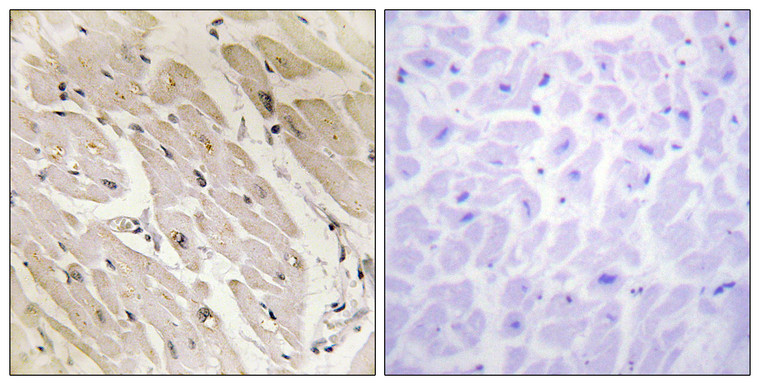| Host: |
Rabbit |
| Applications: |
WB/IHC/IF/ELISA |
| Reactivity: |
Human/Mouse |
| Note: |
STRICTLY FOR FURTHER SCIENTIFIC RESEARCH USE ONLY (RUO). MUST NOT TO BE USED IN DIAGNOSTIC OR THERAPEUTIC APPLICATIONS. |
| Short Description: |
Rabbit polyclonal antibody anti-5 AMP-activated protein kinase subunit gamma-2 (1-50 aa) is suitable for use in Western Blot, Immunohistochemistry, Immunofluorescence and ELISA research applications. |
| Clonality: |
Polyclonal |
| Conjugation: |
Unconjugated |
| Isotype: |
IgG |
| Formulation: |
Liquid in PBS containing 50% Glycerol, 0.5% BSA and 0.02% Sodium Azide. |
| Purification: |
The antibody was affinity-purified from rabbit antiserum by affinity-chromatography using epitope-specific immunogen. |
| Concentration: |
1 mg/mL |
| Dilution Range: |
WB 1:500-1:2000IHC 1:100-1:300IF 1:200-1:1000ELISA 1:20000 |
| Storage Instruction: |
Store at-20°C for up to 1 year from the date of receipt, and avoid repeat freeze-thaw cycles. |
| Gene Symbol: |
PRKAG2 |
| Gene ID: |
51422 |
| Uniprot ID: |
AAKG2_HUMAN |
| Immunogen Region: |
1-50 aa |
| Specificity: |
AMPK Gamma 2 Polyclonal Antibody detects endogenous levels of AMPK Gamma 2 protein. |
| Immunogen: |
The antiserum was produced against synthesized peptide derived from the human PRKAG2 at the amino acid range 1-50 |
| Post Translational Modifications | Phosphorylated by ULK1.leading to negatively regulate AMPK activity and suggesting the existence of a regulatory feedback loop between ULK1 and AMPK. |
| Function | AMP/ATP-binding subunit of AMP-activated protein kinase (AMPK), an energy sensor protein kinase that plays a key role in regulating cellular energy metabolism. In response to reduction of intracellular ATP levels, AMPK activates energy-producing pathways and inhibits energy-consuming processes: inhibits protein, carbohydrate and lipid biosynthesis, as well as cell growth and proliferation. AMPK acts via direct phosphorylation of metabolic enzymes, and by longer-term effects via phosphorylation of transcription regulators. Also acts as a regulator of cellular polarity by remodeling the actin cytoskeleton.probably by indirectly activating myosin. Gamma non-catalytic subunit mediates binding to AMP, ADP and ATP, leading to activate or inhibit AMPK: AMP-binding results in allosteric activation of alpha catalytic subunit (PRKAA1 or PRKAA2) both by inducing phosphorylation and preventing dephosphorylation of catalytic subunits. ADP also stimulates phosphorylation, without stimulating already phosphorylated catalytic subunit. ATP promotes dephosphorylation of catalytic subunit, rendering the AMPK enzyme inactive. |
| Protein Name | 5'-Amp-Activated Protein Kinase Subunit Gamma-2Ampk Gamma2Ampk Subunit Gamma-2H91620p |
| Database Links | Reactome: R-HSA-1445148Reactome: R-HSA-1632852Reactome: R-HSA-163680Reactome: R-HSA-200425Reactome: R-HSA-2151209Reactome: R-HSA-380972Reactome: R-HSA-5628897Reactome: R-HSA-6804756Reactome: R-HSA-9613354Reactome: R-HSA-9619483 |
| Alternative Antibody Names | Anti-5'-Amp-Activated Protein Kinase Subunit Gamma-2 antibodyAnti-Ampk Gamma2 antibodyAnti-Ampk Subunit Gamma-2 antibodyAnti-H91620p antibodyAnti-PRKAG2 antibody |
Information sourced from Uniprot.org
12 months for antibodies. 6 months for ELISA Kits. Please see website T&Cs for further guidance









